Logistics and Supply Chain Management Report: A Tesco Perspective
VerifiedAdded on 2023/06/14
|16
|5309
|308
Report
AI Summary
This report provides an in-depth analysis of logistics and supply chain management within the context of Tesco, a leading supermarket brand headquartered in the UK. It explores key supply chain concepts, principles, and processes, highlighting their contribution to Tesco's competitiveness. The report discusses issues associated with developing a robust supply chain strategy, including the importance of technology, handling processes, supply chain associations, and risk management. Furthermore, it examines the interrelationships between the supply chain and other areas of the organization, emphasizing the need for collaboration and integration. The analysis showcases how Tesco leverages its supply chain to achieve its mission of creating value for customers through efficient operations, cost reduction, and timely delivery of high-quality products, while also addressing potential disruptions and complexities in the supply chain.
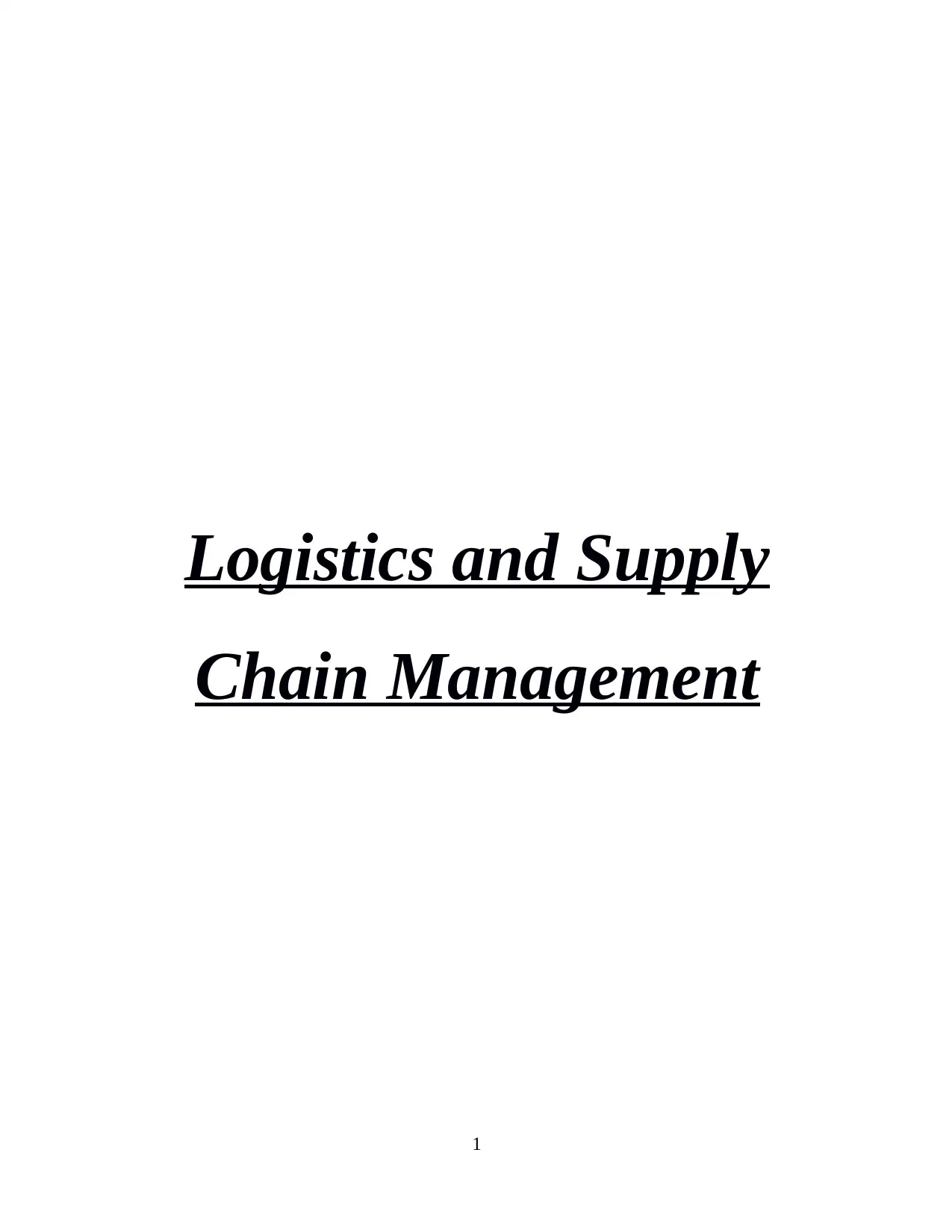
Logistics and Supply
Chain Management
1
Chain Management
1
Paraphrase This Document
Need a fresh take? Get an instant paraphrase of this document with our AI Paraphraser
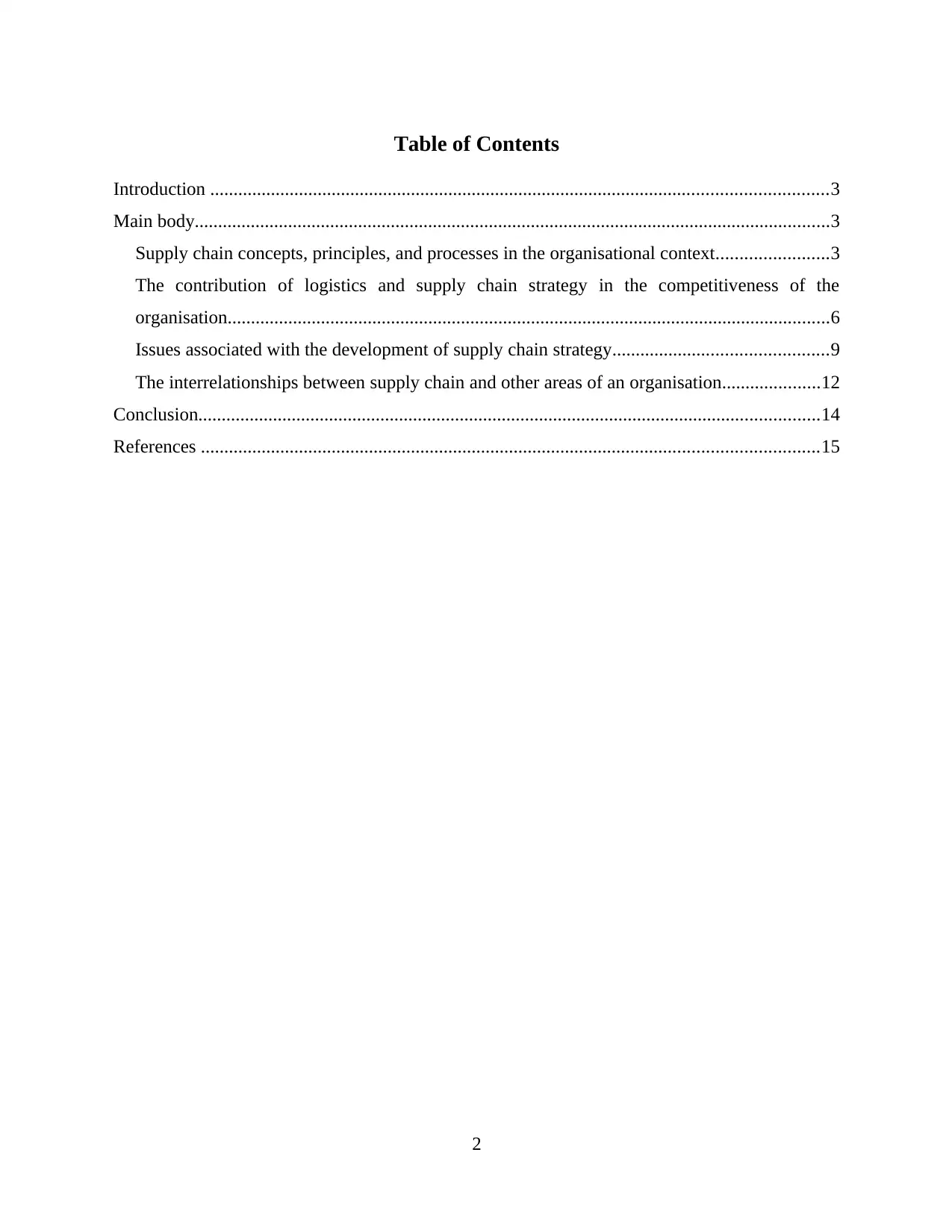
Table of Contents
Introduction ....................................................................................................................................3
Main body........................................................................................................................................3
Supply chain concepts, principles, and processes in the organisational context........................3
The contribution of logistics and supply chain strategy in the competitiveness of the
organisation.................................................................................................................................6
Issues associated with the development of supply chain strategy..............................................9
The interrelationships between supply chain and other areas of an organisation.....................12
Conclusion.....................................................................................................................................14
References ....................................................................................................................................15
2
Introduction ....................................................................................................................................3
Main body........................................................................................................................................3
Supply chain concepts, principles, and processes in the organisational context........................3
The contribution of logistics and supply chain strategy in the competitiveness of the
organisation.................................................................................................................................6
Issues associated with the development of supply chain strategy..............................................9
The interrelationships between supply chain and other areas of an organisation.....................12
Conclusion.....................................................................................................................................14
References ....................................................................................................................................15
2
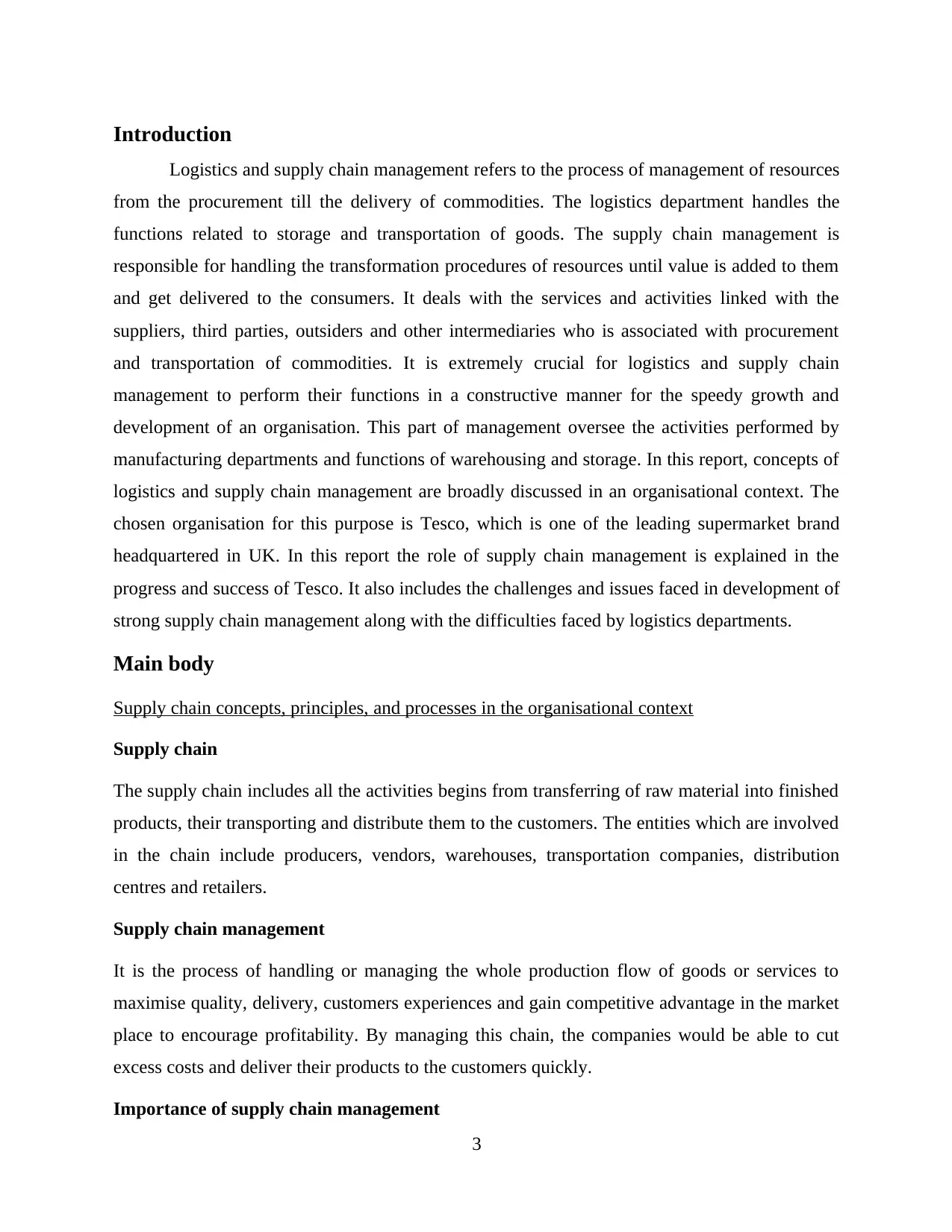
Introduction
Logistics and supply chain management refers to the process of management of resources
from the procurement till the delivery of commodities. The logistics department handles the
functions related to storage and transportation of goods. The supply chain management is
responsible for handling the transformation procedures of resources until value is added to them
and get delivered to the consumers. It deals with the services and activities linked with the
suppliers, third parties, outsiders and other intermediaries who is associated with procurement
and transportation of commodities. It is extremely crucial for logistics and supply chain
management to perform their functions in a constructive manner for the speedy growth and
development of an organisation. This part of management oversee the activities performed by
manufacturing departments and functions of warehousing and storage. In this report, concepts of
logistics and supply chain management are broadly discussed in an organisational context. The
chosen organisation for this purpose is Tesco, which is one of the leading supermarket brand
headquartered in UK. In this report the role of supply chain management is explained in the
progress and success of Tesco. It also includes the challenges and issues faced in development of
strong supply chain management along with the difficulties faced by logistics departments.
Main body
Supply chain concepts, principles, and processes in the organisational context
Supply chain
The supply chain includes all the activities begins from transferring of raw material into finished
products, their transporting and distribute them to the customers. The entities which are involved
in the chain include producers, vendors, warehouses, transportation companies, distribution
centres and retailers.
Supply chain management
It is the process of handling or managing the whole production flow of goods or services to
maximise quality, delivery, customers experiences and gain competitive advantage in the market
place to encourage profitability. By managing this chain, the companies would be able to cut
excess costs and deliver their products to the customers quickly.
Importance of supply chain management
3
Logistics and supply chain management refers to the process of management of resources
from the procurement till the delivery of commodities. The logistics department handles the
functions related to storage and transportation of goods. The supply chain management is
responsible for handling the transformation procedures of resources until value is added to them
and get delivered to the consumers. It deals with the services and activities linked with the
suppliers, third parties, outsiders and other intermediaries who is associated with procurement
and transportation of commodities. It is extremely crucial for logistics and supply chain
management to perform their functions in a constructive manner for the speedy growth and
development of an organisation. This part of management oversee the activities performed by
manufacturing departments and functions of warehousing and storage. In this report, concepts of
logistics and supply chain management are broadly discussed in an organisational context. The
chosen organisation for this purpose is Tesco, which is one of the leading supermarket brand
headquartered in UK. In this report the role of supply chain management is explained in the
progress and success of Tesco. It also includes the challenges and issues faced in development of
strong supply chain management along with the difficulties faced by logistics departments.
Main body
Supply chain concepts, principles, and processes in the organisational context
Supply chain
The supply chain includes all the activities begins from transferring of raw material into finished
products, their transporting and distribute them to the customers. The entities which are involved
in the chain include producers, vendors, warehouses, transportation companies, distribution
centres and retailers.
Supply chain management
It is the process of handling or managing the whole production flow of goods or services to
maximise quality, delivery, customers experiences and gain competitive advantage in the market
place to encourage profitability. By managing this chain, the companies would be able to cut
excess costs and deliver their products to the customers quickly.
Importance of supply chain management
3
⊘ This is a preview!⊘
Do you want full access?
Subscribe today to unlock all pages.

Trusted by 1+ million students worldwide
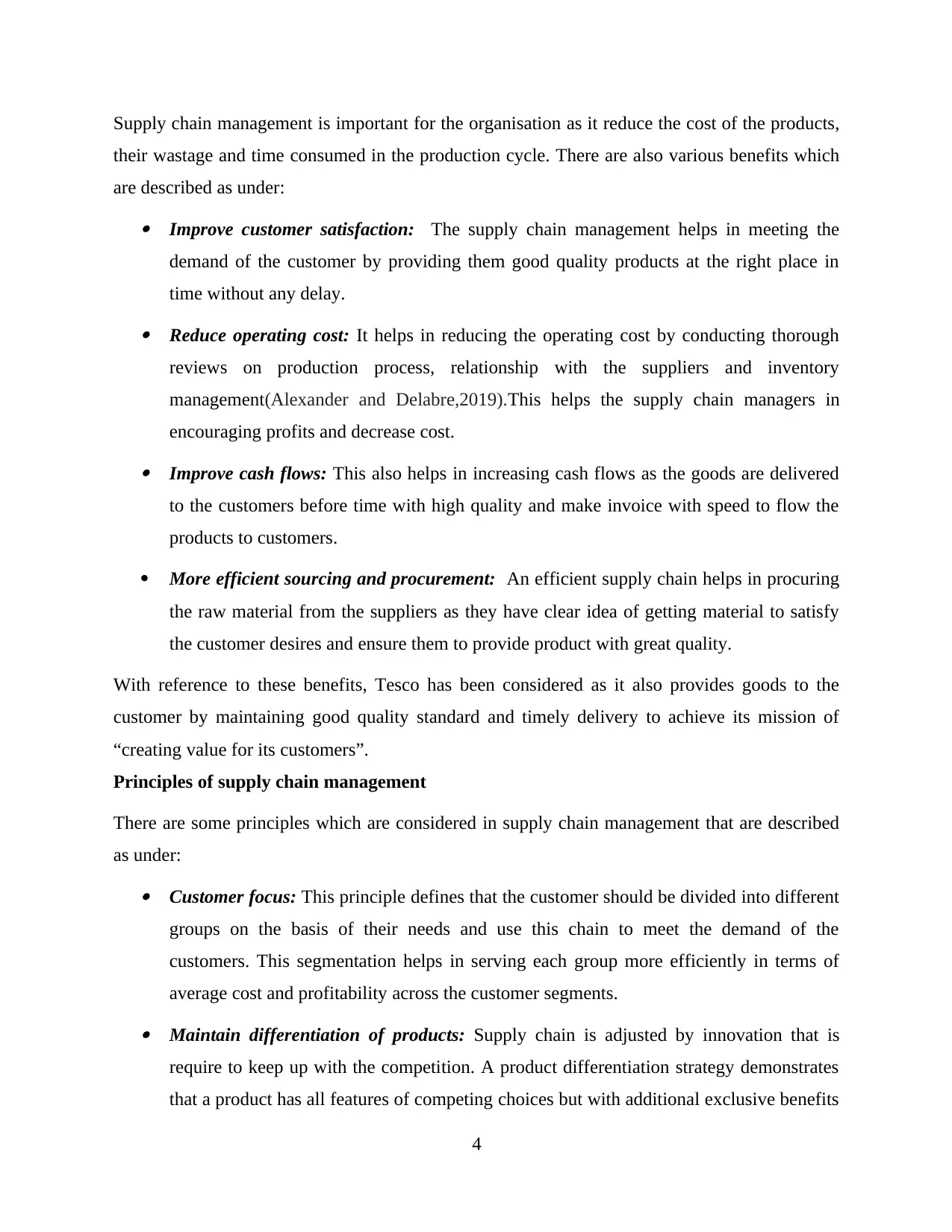
Supply chain management is important for the organisation as it reduce the cost of the products,
their wastage and time consumed in the production cycle. There are also various benefits which
are described as under: Improve customer satisfaction: The supply chain management helps in meeting the
demand of the customer by providing them good quality products at the right place in
time without any delay. Reduce operating cost: It helps in reducing the operating cost by conducting thorough
reviews on production process, relationship with the suppliers and inventory
management(Alexander and Delabre,2019).This helps the supply chain managers in
encouraging profits and decrease cost. Improve cash flows: This also helps in increasing cash flows as the goods are delivered
to the customers before time with high quality and make invoice with speed to flow the
products to customers.
More efficient sourcing and procurement: An efficient supply chain helps in procuring
the raw material from the suppliers as they have clear idea of getting material to satisfy
the customer desires and ensure them to provide product with great quality.
With reference to these benefits, Tesco has been considered as it also provides goods to the
customer by maintaining good quality standard and timely delivery to achieve its mission of
“creating value for its customers”.
Principles of supply chain management
There are some principles which are considered in supply chain management that are described
as under: Customer focus: This principle defines that the customer should be divided into different
groups on the basis of their needs and use this chain to meet the demand of the
customers. This segmentation helps in serving each group more efficiently in terms of
average cost and profitability across the customer segments. Maintain differentiation of products: Supply chain is adjusted by innovation that is
require to keep up with the competition. A product differentiation strategy demonstrates
that a product has all features of competing choices but with additional exclusive benefits
4
their wastage and time consumed in the production cycle. There are also various benefits which
are described as under: Improve customer satisfaction: The supply chain management helps in meeting the
demand of the customer by providing them good quality products at the right place in
time without any delay. Reduce operating cost: It helps in reducing the operating cost by conducting thorough
reviews on production process, relationship with the suppliers and inventory
management(Alexander and Delabre,2019).This helps the supply chain managers in
encouraging profits and decrease cost. Improve cash flows: This also helps in increasing cash flows as the goods are delivered
to the customers before time with high quality and make invoice with speed to flow the
products to customers.
More efficient sourcing and procurement: An efficient supply chain helps in procuring
the raw material from the suppliers as they have clear idea of getting material to satisfy
the customer desires and ensure them to provide product with great quality.
With reference to these benefits, Tesco has been considered as it also provides goods to the
customer by maintaining good quality standard and timely delivery to achieve its mission of
“creating value for its customers”.
Principles of supply chain management
There are some principles which are considered in supply chain management that are described
as under: Customer focus: This principle defines that the customer should be divided into different
groups on the basis of their needs and use this chain to meet the demand of the
customers. This segmentation helps in serving each group more efficiently in terms of
average cost and profitability across the customer segments. Maintain differentiation of products: Supply chain is adjusted by innovation that is
require to keep up with the competition. A product differentiation strategy demonstrates
that a product has all features of competing choices but with additional exclusive benefits
4
Paraphrase This Document
Need a fresh take? Get an instant paraphrase of this document with our AI Paraphraser
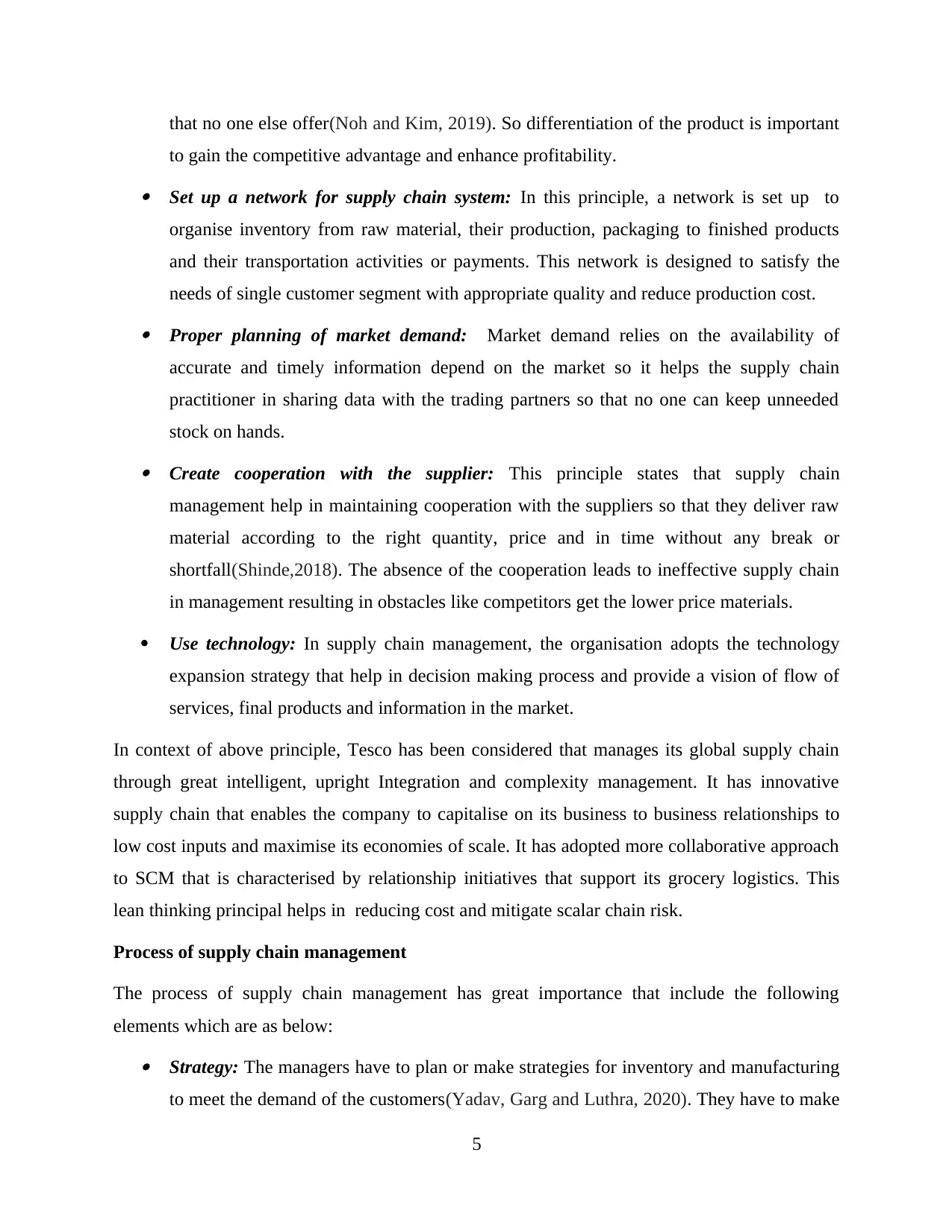
that no one else offer(Noh and Kim, 2019). So differentiation of the product is important
to gain the competitive advantage and enhance profitability. Set up a network for supply chain system: In this principle, a network is set up to
organise inventory from raw material, their production, packaging to finished products
and their transportation activities or payments. This network is designed to satisfy the
needs of single customer segment with appropriate quality and reduce production cost. Proper planning of market demand: Market demand relies on the availability of
accurate and timely information depend on the market so it helps the supply chain
practitioner in sharing data with the trading partners so that no one can keep unneeded
stock on hands. Create cooperation with the supplier: This principle states that supply chain
management help in maintaining cooperation with the suppliers so that they deliver raw
material according to the right quantity, price and in time without any break or
shortfall(Shinde,2018). The absence of the cooperation leads to ineffective supply chain
in management resulting in obstacles like competitors get the lower price materials.
Use technology: In supply chain management, the organisation adopts the technology
expansion strategy that help in decision making process and provide a vision of flow of
services, final products and information in the market.
In context of above principle, Tesco has been considered that manages its global supply chain
through great intelligent, upright Integration and complexity management. It has innovative
supply chain that enables the company to capitalise on its business to business relationships to
low cost inputs and maximise its economies of scale. It has adopted more collaborative approach
to SCM that is characterised by relationship initiatives that support its grocery logistics. This
lean thinking principal helps in reducing cost and mitigate scalar chain risk.
Process of supply chain management
The process of supply chain management has great importance that include the following
elements which are as below: Strategy: The managers have to plan or make strategies for inventory and manufacturing
to meet the demand of the customers(Yadav, Garg and Luthra, 2020). They have to make
5
to gain the competitive advantage and enhance profitability. Set up a network for supply chain system: In this principle, a network is set up to
organise inventory from raw material, their production, packaging to finished products
and their transportation activities or payments. This network is designed to satisfy the
needs of single customer segment with appropriate quality and reduce production cost. Proper planning of market demand: Market demand relies on the availability of
accurate and timely information depend on the market so it helps the supply chain
practitioner in sharing data with the trading partners so that no one can keep unneeded
stock on hands. Create cooperation with the supplier: This principle states that supply chain
management help in maintaining cooperation with the suppliers so that they deliver raw
material according to the right quantity, price and in time without any break or
shortfall(Shinde,2018). The absence of the cooperation leads to ineffective supply chain
in management resulting in obstacles like competitors get the lower price materials.
Use technology: In supply chain management, the organisation adopts the technology
expansion strategy that help in decision making process and provide a vision of flow of
services, final products and information in the market.
In context of above principle, Tesco has been considered that manages its global supply chain
through great intelligent, upright Integration and complexity management. It has innovative
supply chain that enables the company to capitalise on its business to business relationships to
low cost inputs and maximise its economies of scale. It has adopted more collaborative approach
to SCM that is characterised by relationship initiatives that support its grocery logistics. This
lean thinking principal helps in reducing cost and mitigate scalar chain risk.
Process of supply chain management
The process of supply chain management has great importance that include the following
elements which are as below: Strategy: The managers have to plan or make strategies for inventory and manufacturing
to meet the demand of the customers(Yadav, Garg and Luthra, 2020). They have to make
5
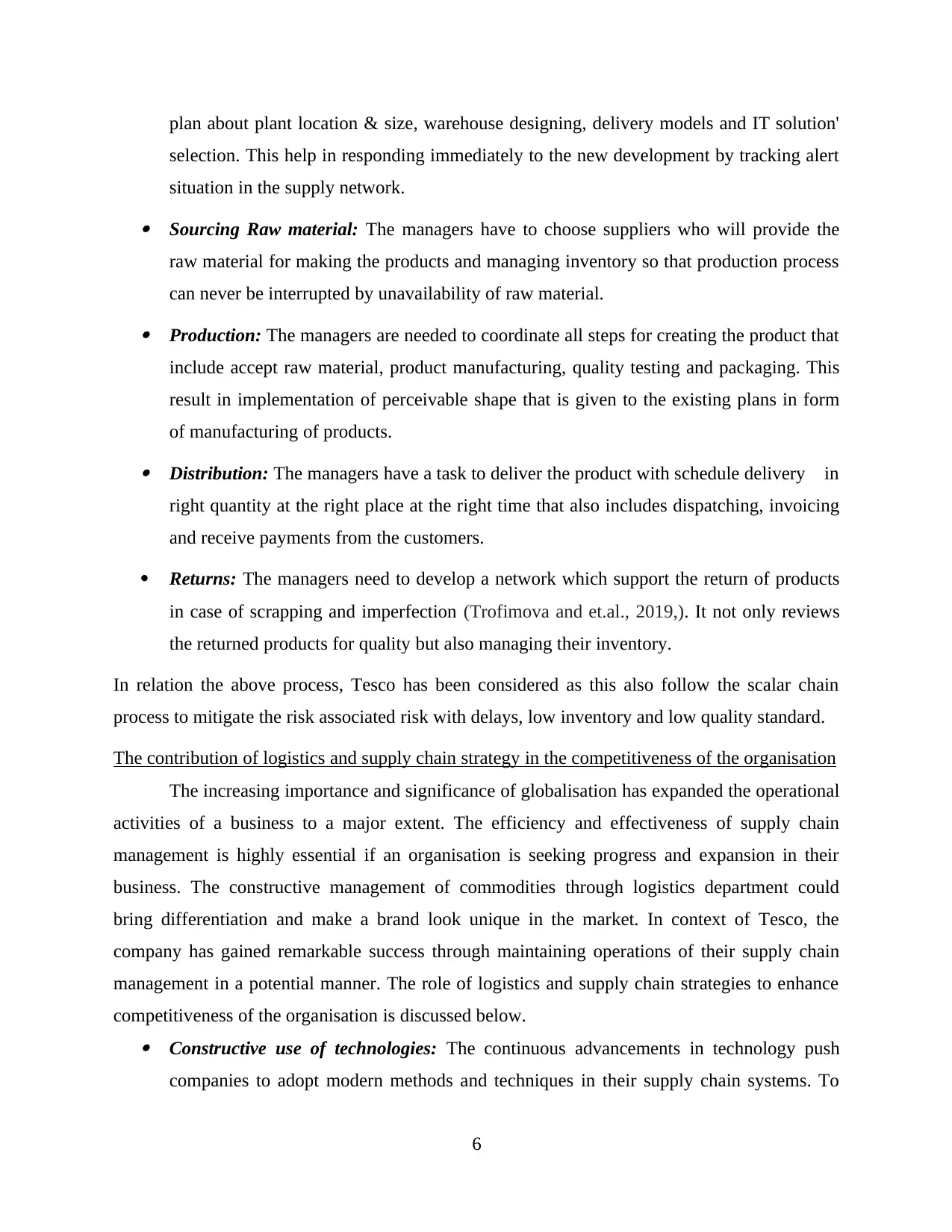
plan about plant location & size, warehouse designing, delivery models and IT solution'
selection. This help in responding immediately to the new development by tracking alert
situation in the supply network. Sourcing Raw material: The managers have to choose suppliers who will provide the
raw material for making the products and managing inventory so that production process
can never be interrupted by unavailability of raw material. Production: The managers are needed to coordinate all steps for creating the product that
include accept raw material, product manufacturing, quality testing and packaging. This
result in implementation of perceivable shape that is given to the existing plans in form
of manufacturing of products. Distribution: The managers have a task to deliver the product with schedule delivery in
right quantity at the right place at the right time that also includes dispatching, invoicing
and receive payments from the customers.
Returns: The managers need to develop a network which support the return of products
in case of scrapping and imperfection (Trofimova and et.al., 2019,). It not only reviews
the returned products for quality but also managing their inventory.
In relation the above process, Tesco has been considered as this also follow the scalar chain
process to mitigate the risk associated risk with delays, low inventory and low quality standard.
The contribution of logistics and supply chain strategy in the competitiveness of the organisation
The increasing importance and significance of globalisation has expanded the operational
activities of a business to a major extent. The efficiency and effectiveness of supply chain
management is highly essential if an organisation is seeking progress and expansion in their
business. The constructive management of commodities through logistics department could
bring differentiation and make a brand look unique in the market. In context of Tesco, the
company has gained remarkable success through maintaining operations of their supply chain
management in a potential manner. The role of logistics and supply chain strategies to enhance
competitiveness of the organisation is discussed below. Constructive use of technologies: The continuous advancements in technology push
companies to adopt modern methods and techniques in their supply chain systems. To
6
selection. This help in responding immediately to the new development by tracking alert
situation in the supply network. Sourcing Raw material: The managers have to choose suppliers who will provide the
raw material for making the products and managing inventory so that production process
can never be interrupted by unavailability of raw material. Production: The managers are needed to coordinate all steps for creating the product that
include accept raw material, product manufacturing, quality testing and packaging. This
result in implementation of perceivable shape that is given to the existing plans in form
of manufacturing of products. Distribution: The managers have a task to deliver the product with schedule delivery in
right quantity at the right place at the right time that also includes dispatching, invoicing
and receive payments from the customers.
Returns: The managers need to develop a network which support the return of products
in case of scrapping and imperfection (Trofimova and et.al., 2019,). It not only reviews
the returned products for quality but also managing their inventory.
In relation the above process, Tesco has been considered as this also follow the scalar chain
process to mitigate the risk associated risk with delays, low inventory and low quality standard.
The contribution of logistics and supply chain strategy in the competitiveness of the organisation
The increasing importance and significance of globalisation has expanded the operational
activities of a business to a major extent. The efficiency and effectiveness of supply chain
management is highly essential if an organisation is seeking progress and expansion in their
business. The constructive management of commodities through logistics department could
bring differentiation and make a brand look unique in the market. In context of Tesco, the
company has gained remarkable success through maintaining operations of their supply chain
management in a potential manner. The role of logistics and supply chain strategies to enhance
competitiveness of the organisation is discussed below. Constructive use of technologies: The continuous advancements in technology push
companies to adopt modern methods and techniques in their supply chain systems. To
6
⊘ This is a preview!⊘
Do you want full access?
Subscribe today to unlock all pages.

Trusted by 1+ million students worldwide

develop competitive advantage, an organisation should focus upon the optimisation of
technologies to avoid delays and disruption. In context to tesco, the company should
make effective use of automation through robots which will enable the enterprise to
execute their production with efficiency. In addition to this, it should focus on investing
their funds in the development of high tech machines and equipments with sensors to
fasten the procedures (Liu and et.al., 2018). The use of advanced analytics should be
encouraged which allow the organisation in the ascertainment of errors prior to their
occurrence. Large scale enterprises implement their procedures through automated
processes which reduce the risk of human error and bring efficiency in supply chain
management. The optimum use of artificial intelligence advanced the processes of supply
chain techniques. It helps in avoiding delays and facilitate automation saving the cost of
overheads to a great extent. Focusing improvements in handling processes: The disruptions in supply chain
management could be caused due to political disturbances, government interruptions,
technical errors and natural calamities which are beyond human control. The anticipation
and forecasting of happenings which might disrupt the flow of production is very crucial
to cope with uncertainties. The proper management of logistics and supply chain
processes is highly significant to induce customer base of an organisation. In context to
Tesco, the company is known for their services which indicates the efficiency in their
supply chain undertakings. The company put supply chain management on top priority
which enable it to predict mishaps that could occur due to any reason. Supply chain
execution should be integrated with the overall functioning of an organisation. The
collaboration of logistics and supply chain departments with other operational areas
ensures that the business activities are conducted in constructive manner. The company
pays attention on the working of channels associated with supply chain and ensures that
their partners work with balance and cooperation (Prockl and et.al., 2018). The
individuals involved in the management of supply chain should be individually assessed
for their functioning to measure success of operations. The application of six sigma could
enhance the working of the company through eliminating errors and maximum utilisation
of resources.
7
technologies to avoid delays and disruption. In context to tesco, the company should
make effective use of automation through robots which will enable the enterprise to
execute their production with efficiency. In addition to this, it should focus on investing
their funds in the development of high tech machines and equipments with sensors to
fasten the procedures (Liu and et.al., 2018). The use of advanced analytics should be
encouraged which allow the organisation in the ascertainment of errors prior to their
occurrence. Large scale enterprises implement their procedures through automated
processes which reduce the risk of human error and bring efficiency in supply chain
management. The optimum use of artificial intelligence advanced the processes of supply
chain techniques. It helps in avoiding delays and facilitate automation saving the cost of
overheads to a great extent. Focusing improvements in handling processes: The disruptions in supply chain
management could be caused due to political disturbances, government interruptions,
technical errors and natural calamities which are beyond human control. The anticipation
and forecasting of happenings which might disrupt the flow of production is very crucial
to cope with uncertainties. The proper management of logistics and supply chain
processes is highly significant to induce customer base of an organisation. In context to
Tesco, the company is known for their services which indicates the efficiency in their
supply chain undertakings. The company put supply chain management on top priority
which enable it to predict mishaps that could occur due to any reason. Supply chain
execution should be integrated with the overall functioning of an organisation. The
collaboration of logistics and supply chain departments with other operational areas
ensures that the business activities are conducted in constructive manner. The company
pays attention on the working of channels associated with supply chain and ensures that
their partners work with balance and cooperation (Prockl and et.al., 2018). The
individuals involved in the management of supply chain should be individually assessed
for their functioning to measure success of operations. The application of six sigma could
enhance the working of the company through eliminating errors and maximum utilisation
of resources.
7
Paraphrase This Document
Need a fresh take? Get an instant paraphrase of this document with our AI Paraphraser

Emphasis on supply chain associations and channel partners: The effectiveness of
partnerships and associations involved in supply chain management is critical for the
proper working of logistics departments. The delays and errors occurred in working of
third parties highly impact the performance of supply chain departments. Supply
channels and partnered associations influence the costs incurred and timely completion of
tasks for an organisation. In context to Tesco ensures that it maintains good relations with
their supply chain partners to establish high productivity and efficiency in their
operations. To maintain good conduct with supply chain partners, the company work in
coordination to achieve their organisational objectives (Wijewickrama and et.al., 2021).
The associations related to the supply chain management should be frequently evaluated
to determine the effectiveness of operations. The organisation and their partners works
with their best individual efforts to attain targets collectively. The company focus on
continuous improvement in the collaboration with their working partners. For this
purpose, it evaluates and discover ways which reduce delays and focus upon cost
reduction. The company analyse the errors and roadblocks which hamper their effective
supply chain management.
Evaluating complexities and risks involved: The procedures and methods involved in
the management of supply chain execution and logistics is complex. The process of
supply chain is very lengthy with the involvement of too many people performing
multiple tasks. In order to deal with complexities, predetermining risks and threats is
significant to avoid troubles. In context to tesco, the company works with their
stakeholders with cooperation to deal with uncertainties that are beyond human control.
Performance of an organisation cannot be enhanced if everything is managed
individually without support of stakeholders (Liu and et.al., 2018). Large scale
companies like Tesco conducts their operations with collective approach to bring
efficiency in their supply chain management. Focusing on effectiveness among supply
chain team and partners improves the performance of the company through innovative
techniques with cost reduction. The organisation pays attention on the optimisation of
resources which is achieved through collaboration provided by supply chain partners and
stakeholders.
8
partnerships and associations involved in supply chain management is critical for the
proper working of logistics departments. The delays and errors occurred in working of
third parties highly impact the performance of supply chain departments. Supply
channels and partnered associations influence the costs incurred and timely completion of
tasks for an organisation. In context to Tesco ensures that it maintains good relations with
their supply chain partners to establish high productivity and efficiency in their
operations. To maintain good conduct with supply chain partners, the company work in
coordination to achieve their organisational objectives (Wijewickrama and et.al., 2021).
The associations related to the supply chain management should be frequently evaluated
to determine the effectiveness of operations. The organisation and their partners works
with their best individual efforts to attain targets collectively. The company focus on
continuous improvement in the collaboration with their working partners. For this
purpose, it evaluates and discover ways which reduce delays and focus upon cost
reduction. The company analyse the errors and roadblocks which hamper their effective
supply chain management.
Evaluating complexities and risks involved: The procedures and methods involved in
the management of supply chain execution and logistics is complex. The process of
supply chain is very lengthy with the involvement of too many people performing
multiple tasks. In order to deal with complexities, predetermining risks and threats is
significant to avoid troubles. In context to tesco, the company works with their
stakeholders with cooperation to deal with uncertainties that are beyond human control.
Performance of an organisation cannot be enhanced if everything is managed
individually without support of stakeholders (Liu and et.al., 2018). Large scale
companies like Tesco conducts their operations with collective approach to bring
efficiency in their supply chain management. Focusing on effectiveness among supply
chain team and partners improves the performance of the company through innovative
techniques with cost reduction. The organisation pays attention on the optimisation of
resources which is achieved through collaboration provided by supply chain partners and
stakeholders.
8
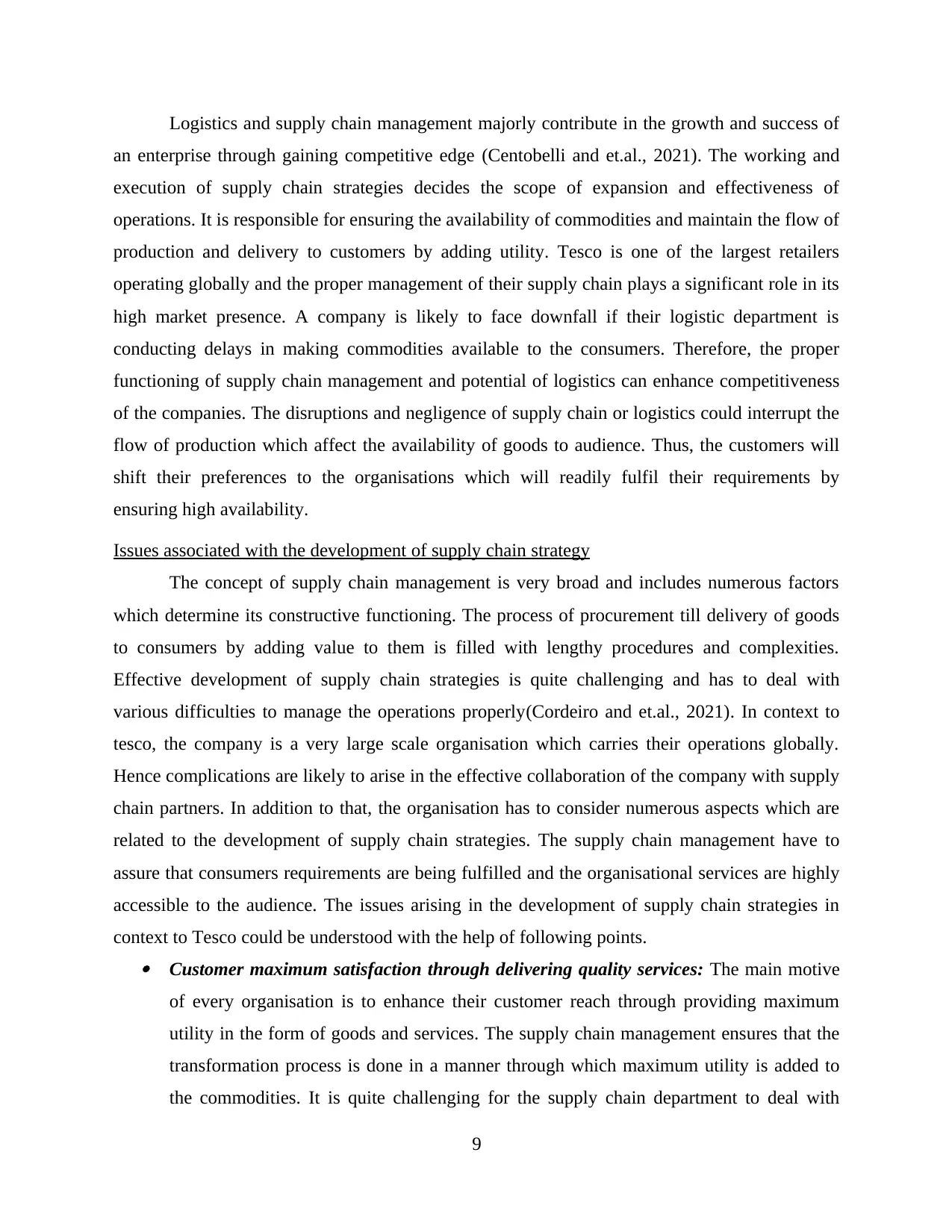
Logistics and supply chain management majorly contribute in the growth and success of
an enterprise through gaining competitive edge (Centobelli and et.al., 2021). The working and
execution of supply chain strategies decides the scope of expansion and effectiveness of
operations. It is responsible for ensuring the availability of commodities and maintain the flow of
production and delivery to customers by adding utility. Tesco is one of the largest retailers
operating globally and the proper management of their supply chain plays a significant role in its
high market presence. A company is likely to face downfall if their logistic department is
conducting delays in making commodities available to the consumers. Therefore, the proper
functioning of supply chain management and potential of logistics can enhance competitiveness
of the companies. The disruptions and negligence of supply chain or logistics could interrupt the
flow of production which affect the availability of goods to audience. Thus, the customers will
shift their preferences to the organisations which will readily fulfil their requirements by
ensuring high availability.
Issues associated with the development of supply chain strategy
The concept of supply chain management is very broad and includes numerous factors
which determine its constructive functioning. The process of procurement till delivery of goods
to consumers by adding value to them is filled with lengthy procedures and complexities.
Effective development of supply chain strategies is quite challenging and has to deal with
various difficulties to manage the operations properly(Cordeiro and et.al., 2021). In context to
tesco, the company is a very large scale organisation which carries their operations globally.
Hence complications are likely to arise in the effective collaboration of the company with supply
chain partners. In addition to that, the organisation has to consider numerous aspects which are
related to the development of supply chain strategies. The supply chain management have to
assure that consumers requirements are being fulfilled and the organisational services are highly
accessible to the audience. The issues arising in the development of supply chain strategies in
context to Tesco could be understood with the help of following points. Customer maximum satisfaction through delivering quality services: The main motive
of every organisation is to enhance their customer reach through providing maximum
utility in the form of goods and services. The supply chain management ensures that the
transformation process is done in a manner through which maximum utility is added to
the commodities. It is quite challenging for the supply chain department to deal with
9
an enterprise through gaining competitive edge (Centobelli and et.al., 2021). The working and
execution of supply chain strategies decides the scope of expansion and effectiveness of
operations. It is responsible for ensuring the availability of commodities and maintain the flow of
production and delivery to customers by adding utility. Tesco is one of the largest retailers
operating globally and the proper management of their supply chain plays a significant role in its
high market presence. A company is likely to face downfall if their logistic department is
conducting delays in making commodities available to the consumers. Therefore, the proper
functioning of supply chain management and potential of logistics can enhance competitiveness
of the companies. The disruptions and negligence of supply chain or logistics could interrupt the
flow of production which affect the availability of goods to audience. Thus, the customers will
shift their preferences to the organisations which will readily fulfil their requirements by
ensuring high availability.
Issues associated with the development of supply chain strategy
The concept of supply chain management is very broad and includes numerous factors
which determine its constructive functioning. The process of procurement till delivery of goods
to consumers by adding value to them is filled with lengthy procedures and complexities.
Effective development of supply chain strategies is quite challenging and has to deal with
various difficulties to manage the operations properly(Cordeiro and et.al., 2021). In context to
tesco, the company is a very large scale organisation which carries their operations globally.
Hence complications are likely to arise in the effective collaboration of the company with supply
chain partners. In addition to that, the organisation has to consider numerous aspects which are
related to the development of supply chain strategies. The supply chain management have to
assure that consumers requirements are being fulfilled and the organisational services are highly
accessible to the audience. The issues arising in the development of supply chain strategies in
context to Tesco could be understood with the help of following points. Customer maximum satisfaction through delivering quality services: The main motive
of every organisation is to enhance their customer reach through providing maximum
utility in the form of goods and services. The supply chain management ensures that the
transformation process is done in a manner through which maximum utility is added to
the commodities. It is quite challenging for the supply chain department to deal with
9
⊘ This is a preview!⊘
Do you want full access?
Subscribe today to unlock all pages.

Trusted by 1+ million students worldwide

different preferences and interests of consumers at a time. Consumer's demand varies
with changes in their personal backgrounds and income levels. It becomes complex to
manage production in a way which satisfy the needs and desires of audience with huge
diversities. Problems regarding costs management: The most challenging aspect of supply chain
management is to deal with cost control while maximising output both in terms of quality
and quantity. With increasing globalisation, the cost incurred in the procurement of raw
materials and transformational processes are getting higher. The scarcity of resources and
increasing demand with emergence of businesses made it difficult for supply chain
management to avail resources while controlling costs (Fantazy and Tipu, 2019). In
context to Tesco, the company is widely popular for the quality of their goods and
services. It becomes very challenging for the company to maintain its best quality with
reduction in their costs. Risks associated in business environment: The market constantly keeps changing and
evolving with changes in trends and preferences of buyers. Business operates in a
dynamic environment where changes cannot be predicted and prevented. Logistic
department could face severe delays and interruptions which could be caused through
changes occurring in external business environment. In context to tesco, its complex
operations implies involvement of various elements which makes it difficult to ascertain
changes that could impact the performance of supply chain management. The constantly
evolving market makes it difficult to frame strategies for the effectiveness of logistics
and supply chain functioning. Relationships with supply partners: The performance and potential of supply partners
directly determine the effectiveness of the logistics and supply chain development.
Problems arise when associated supply channels do not perform their work with best
efforts (Yang, 2018). The delays caused by outsiders and suppliers in the procurement of
raw materials affect the transformation process. Delays occurring in the supply chain
processes could further make the transportation process slow and affect the availability of
commodities. Issues related to competence of employees: Another challenge faced in the process of
supply chain management is the incompetence and inefficiency of employees. It has
10
with changes in their personal backgrounds and income levels. It becomes complex to
manage production in a way which satisfy the needs and desires of audience with huge
diversities. Problems regarding costs management: The most challenging aspect of supply chain
management is to deal with cost control while maximising output both in terms of quality
and quantity. With increasing globalisation, the cost incurred in the procurement of raw
materials and transformational processes are getting higher. The scarcity of resources and
increasing demand with emergence of businesses made it difficult for supply chain
management to avail resources while controlling costs (Fantazy and Tipu, 2019). In
context to Tesco, the company is widely popular for the quality of their goods and
services. It becomes very challenging for the company to maintain its best quality with
reduction in their costs. Risks associated in business environment: The market constantly keeps changing and
evolving with changes in trends and preferences of buyers. Business operates in a
dynamic environment where changes cannot be predicted and prevented. Logistic
department could face severe delays and interruptions which could be caused through
changes occurring in external business environment. In context to tesco, its complex
operations implies involvement of various elements which makes it difficult to ascertain
changes that could impact the performance of supply chain management. The constantly
evolving market makes it difficult to frame strategies for the effectiveness of logistics
and supply chain functioning. Relationships with supply partners: The performance and potential of supply partners
directly determine the effectiveness of the logistics and supply chain development.
Problems arise when associated supply channels do not perform their work with best
efforts (Yang, 2018). The delays caused by outsiders and suppliers in the procurement of
raw materials affect the transformation process. Delays occurring in the supply chain
processes could further make the transportation process slow and affect the availability of
commodities. Issues related to competence of employees: Another challenge faced in the process of
supply chain management is the incompetence and inefficiency of employees. It has
10
Paraphrase This Document
Need a fresh take? Get an instant paraphrase of this document with our AI Paraphraser
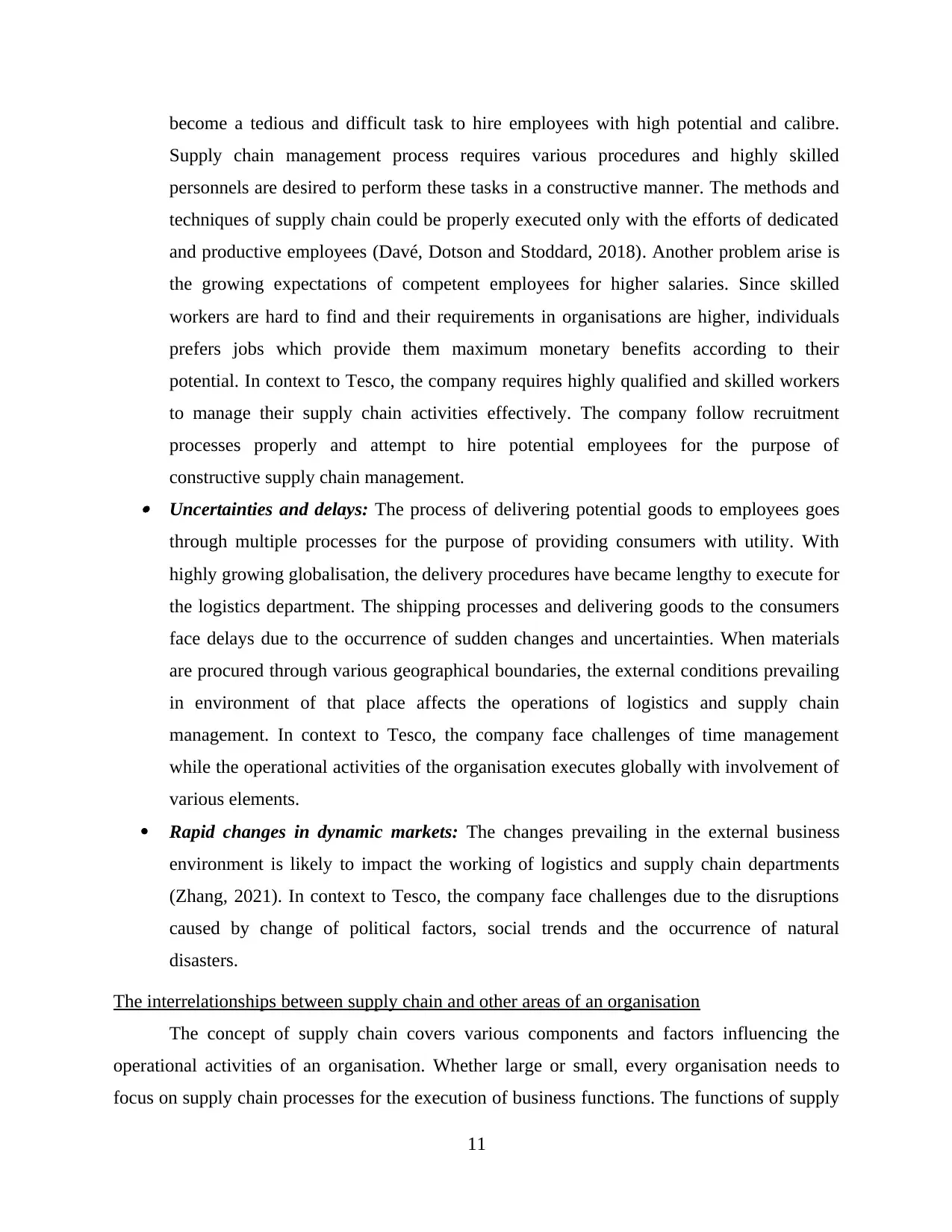
become a tedious and difficult task to hire employees with high potential and calibre.
Supply chain management process requires various procedures and highly skilled
personnels are desired to perform these tasks in a constructive manner. The methods and
techniques of supply chain could be properly executed only with the efforts of dedicated
and productive employees (Davé, Dotson and Stoddard, 2018). Another problem arise is
the growing expectations of competent employees for higher salaries. Since skilled
workers are hard to find and their requirements in organisations are higher, individuals
prefers jobs which provide them maximum monetary benefits according to their
potential. In context to Tesco, the company requires highly qualified and skilled workers
to manage their supply chain activities effectively. The company follow recruitment
processes properly and attempt to hire potential employees for the purpose of
constructive supply chain management. Uncertainties and delays: The process of delivering potential goods to employees goes
through multiple processes for the purpose of providing consumers with utility. With
highly growing globalisation, the delivery procedures have became lengthy to execute for
the logistics department. The shipping processes and delivering goods to the consumers
face delays due to the occurrence of sudden changes and uncertainties. When materials
are procured through various geographical boundaries, the external conditions prevailing
in environment of that place affects the operations of logistics and supply chain
management. In context to Tesco, the company face challenges of time management
while the operational activities of the organisation executes globally with involvement of
various elements.
Rapid changes in dynamic markets: The changes prevailing in the external business
environment is likely to impact the working of logistics and supply chain departments
(Zhang, 2021). In context to Tesco, the company face challenges due to the disruptions
caused by change of political factors, social trends and the occurrence of natural
disasters.
The interrelationships between supply chain and other areas of an organisation
The concept of supply chain covers various components and factors influencing the
operational activities of an organisation. Whether large or small, every organisation needs to
focus on supply chain processes for the execution of business functions. The functions of supply
11
Supply chain management process requires various procedures and highly skilled
personnels are desired to perform these tasks in a constructive manner. The methods and
techniques of supply chain could be properly executed only with the efforts of dedicated
and productive employees (Davé, Dotson and Stoddard, 2018). Another problem arise is
the growing expectations of competent employees for higher salaries. Since skilled
workers are hard to find and their requirements in organisations are higher, individuals
prefers jobs which provide them maximum monetary benefits according to their
potential. In context to Tesco, the company requires highly qualified and skilled workers
to manage their supply chain activities effectively. The company follow recruitment
processes properly and attempt to hire potential employees for the purpose of
constructive supply chain management. Uncertainties and delays: The process of delivering potential goods to employees goes
through multiple processes for the purpose of providing consumers with utility. With
highly growing globalisation, the delivery procedures have became lengthy to execute for
the logistics department. The shipping processes and delivering goods to the consumers
face delays due to the occurrence of sudden changes and uncertainties. When materials
are procured through various geographical boundaries, the external conditions prevailing
in environment of that place affects the operations of logistics and supply chain
management. In context to Tesco, the company face challenges of time management
while the operational activities of the organisation executes globally with involvement of
various elements.
Rapid changes in dynamic markets: The changes prevailing in the external business
environment is likely to impact the working of logistics and supply chain departments
(Zhang, 2021). In context to Tesco, the company face challenges due to the disruptions
caused by change of political factors, social trends and the occurrence of natural
disasters.
The interrelationships between supply chain and other areas of an organisation
The concept of supply chain covers various components and factors influencing the
operational activities of an organisation. Whether large or small, every organisation needs to
focus on supply chain processes for the execution of business functions. The functions of supply
11
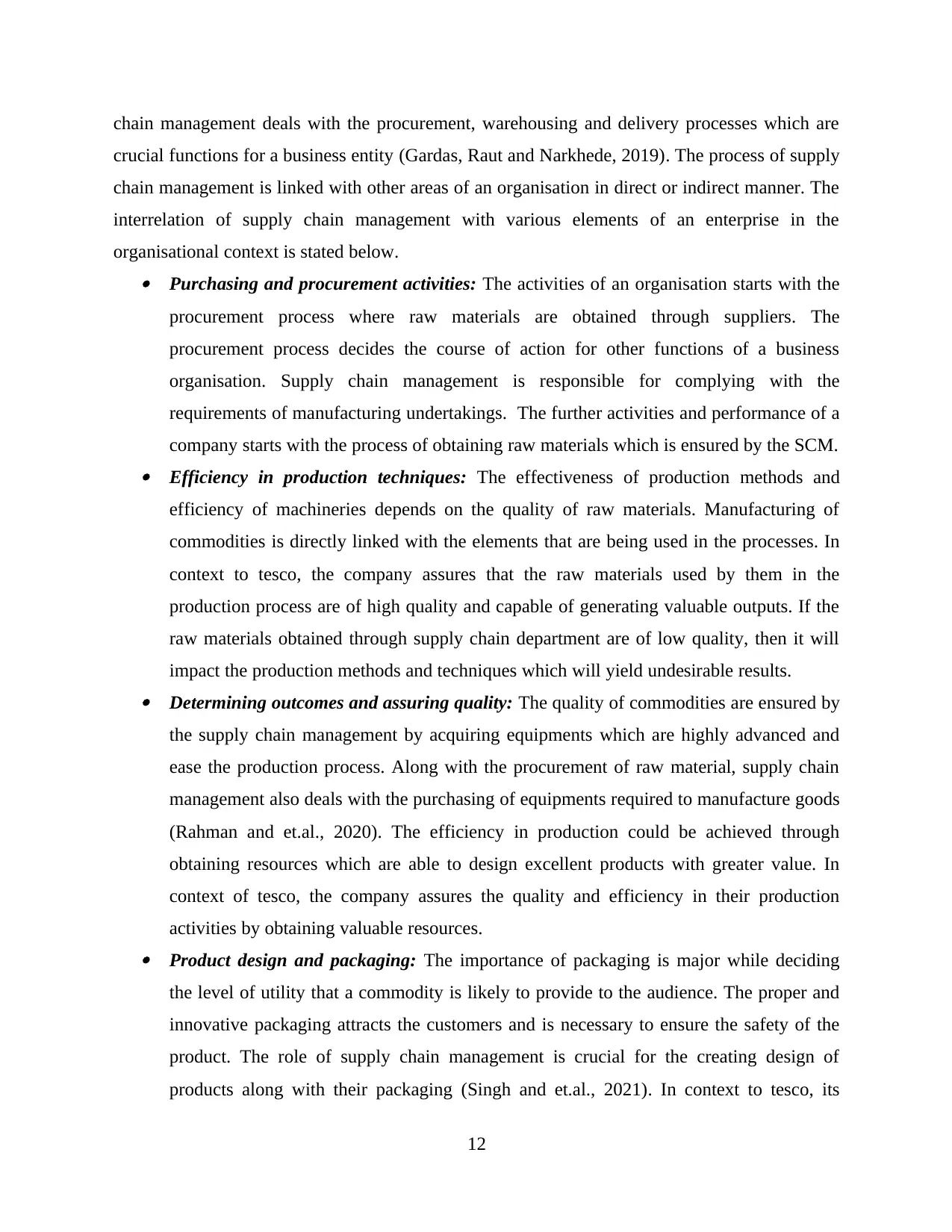
chain management deals with the procurement, warehousing and delivery processes which are
crucial functions for a business entity (Gardas, Raut and Narkhede, 2019). The process of supply
chain management is linked with other areas of an organisation in direct or indirect manner. The
interrelation of supply chain management with various elements of an enterprise in the
organisational context is stated below. Purchasing and procurement activities: The activities of an organisation starts with the
procurement process where raw materials are obtained through suppliers. The
procurement process decides the course of action for other functions of a business
organisation. Supply chain management is responsible for complying with the
requirements of manufacturing undertakings. The further activities and performance of a
company starts with the process of obtaining raw materials which is ensured by the SCM. Efficiency in production techniques: The effectiveness of production methods and
efficiency of machineries depends on the quality of raw materials. Manufacturing of
commodities is directly linked with the elements that are being used in the processes. In
context to tesco, the company assures that the raw materials used by them in the
production process are of high quality and capable of generating valuable outputs. If the
raw materials obtained through supply chain department are of low quality, then it will
impact the production methods and techniques which will yield undesirable results. Determining outcomes and assuring quality: The quality of commodities are ensured by
the supply chain management by acquiring equipments which are highly advanced and
ease the production process. Along with the procurement of raw material, supply chain
management also deals with the purchasing of equipments required to manufacture goods
(Rahman and et.al., 2020). The efficiency in production could be achieved through
obtaining resources which are able to design excellent products with greater value. In
context of tesco, the company assures the quality and efficiency in their production
activities by obtaining valuable resources. Product design and packaging: The importance of packaging is major while deciding
the level of utility that a commodity is likely to provide to the audience. The proper and
innovative packaging attracts the customers and is necessary to ensure the safety of the
product. The role of supply chain management is crucial for the creating design of
products along with their packaging (Singh and et.al., 2021). In context to tesco, its
12
crucial functions for a business entity (Gardas, Raut and Narkhede, 2019). The process of supply
chain management is linked with other areas of an organisation in direct or indirect manner. The
interrelation of supply chain management with various elements of an enterprise in the
organisational context is stated below. Purchasing and procurement activities: The activities of an organisation starts with the
procurement process where raw materials are obtained through suppliers. The
procurement process decides the course of action for other functions of a business
organisation. Supply chain management is responsible for complying with the
requirements of manufacturing undertakings. The further activities and performance of a
company starts with the process of obtaining raw materials which is ensured by the SCM. Efficiency in production techniques: The effectiveness of production methods and
efficiency of machineries depends on the quality of raw materials. Manufacturing of
commodities is directly linked with the elements that are being used in the processes. In
context to tesco, the company assures that the raw materials used by them in the
production process are of high quality and capable of generating valuable outputs. If the
raw materials obtained through supply chain department are of low quality, then it will
impact the production methods and techniques which will yield undesirable results. Determining outcomes and assuring quality: The quality of commodities are ensured by
the supply chain management by acquiring equipments which are highly advanced and
ease the production process. Along with the procurement of raw material, supply chain
management also deals with the purchasing of equipments required to manufacture goods
(Rahman and et.al., 2020). The efficiency in production could be achieved through
obtaining resources which are able to design excellent products with greater value. In
context of tesco, the company assures the quality and efficiency in their production
activities by obtaining valuable resources. Product design and packaging: The importance of packaging is major while deciding
the level of utility that a commodity is likely to provide to the audience. The proper and
innovative packaging attracts the customers and is necessary to ensure the safety of the
product. The role of supply chain management is crucial for the creating design of
products along with their packaging (Singh and et.al., 2021). In context to tesco, its
12
⊘ This is a preview!⊘
Do you want full access?
Subscribe today to unlock all pages.

Trusted by 1+ million students worldwide
1 out of 16
Related Documents
Your All-in-One AI-Powered Toolkit for Academic Success.
+13062052269
info@desklib.com
Available 24*7 on WhatsApp / Email
![[object Object]](/_next/static/media/star-bottom.7253800d.svg)
Unlock your academic potential
Copyright © 2020–2025 A2Z Services. All Rights Reserved. Developed and managed by ZUCOL.





